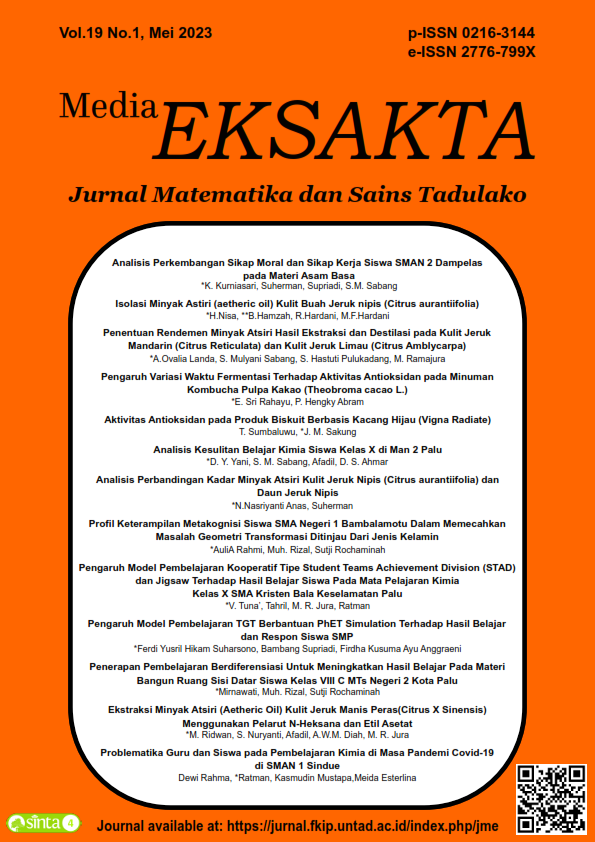Analysis of the type food and content Oreochromis mossambicus and Oreochromis nilotica from Lake Lindu
DOI:
https://doi.org/10.22487/me.v19i1.3461Keywords:
O.mossambicus, O. nilotica, Type food, Nutritional contentAbstract
The purpose of this study was to describe the type and content of food for Mujair and tilapia fish from Lake Lindu by means of a section and taking gastric contents and observing and analyzing them. The stages of the research were fish sampling, surgery (section), research in the laboratory and testing the nutritional content of food (carbohydrates, protein and fat). The research samples were Mujair fish (Oreochromis mossambicus) and Tilapia (Oreochromis nilotica) from Lake Lindu. Based on research obtained by the types of fish food O. mossambicus obtained two groups of Phytoplankton namely, Oedogonium sp, Anabaena sp, Nostoc sp, Oscillatoria princeps, Diatomae sp, Navicula gysingen, Rivularia sp, Coelastrum sphaericum, and Zooplankton namely Chironomus sp, Dugesia tigrina. There were eight types of food for O. nilotica, consisting of six types of phytoplankton, namely Oedogonium sp, Anabaena sp, Nostoc sp, Oscillatoria princeps, Rivularia sp, Coelastrum sphaericum and 2 types of zooplankton feed, namely Chironomus sp and Dugesia tigrina. The nutritional content of fish food/feed is protein (15.18%), fat (19.20%), and carbohydrates (1.9%).
References
Elyana, P. (2011). Pengaruh penambahan ampas kelapa hasil fermentasi Aspergillus oryzae dalam pakan komersial terhadap pertumbuhan ikan nila (Oreochromis niloticus Linn.).
Ernita, E., Faumi, R., Akmal, Y., Muliari, M., & Zulfahmi, I. (2020). Perbandingan Secara Anatomi Insang Ikan Keureling (Tor tambroides), Ikan Mas (Cyprinus carpio) dan Ikan Nila,(Oreochromis niloticus). Jurnal Veteriner, 21(2), 234-246.
Fadri, S., Muchlisin, Z. A., & Sugito, S. (2016). Pertumbuhan, Kelangsungan hidup dan daya cerna Pakanikannila (oreochromisniloticus) Yang Mengandung Tepung Daunjaloh (salixtetrasperma Roxb) Dengan Penambahan Probiotik Em-4 (Doctoral dissertation, Syiah Kuala University).
Hidayati, S. H. (2022). Analisis Kandungan Protein, Zat Besi dan Daya Terima Pempek Ikan Nila (Oreochromis niloticus) dan Bayam (Amaranthus spp). Jurnal Gizi Dan Kesehatan, 14(1), 18-33.
Ilyas, A. P., Nirmala, K., Harris, E., & Widiyanto, T. (2014). Pemanfaatan Lemna perpusilla sebagai pakan kombinasi untuk ikan nila (Oreochromis niloticus) pada sistem resirkulasi. Limnotek: perairan darat tropis di Indonesia, 21(2).
Noviana, P. (2014). Pengaruh Pemberian Probiotik Dalam Pakan Buatan Terhadap Tingkat Konsumsi Pakan Dan Pertumbuhan Benih Ikan Nila (Oreochromis Niloticus). Journal of Aquaculture Management and Technology, 3(4), 183-190.
Prabowo, B. T., Susilowati, T., & Nugroho, R. A. (2016). Analisis karakter reproduksi ikan nila pandu (F6)(Oreochromis niloticus) persilangan strain nila merah singapura menggunakan sistem resiprokal pada pendederan I. Journal of Aquaculture Management and Technology, 5(1), 54-63.
Ramlah, R., Soekendarsi, E., Hasyim, Z., & Hassan, M. S. (2016). Perbandingan kandungan gizi ikan nila Oreochromis niloticus asal danau mawang Kabupaten Gowa dan danau Universitas Hasanuddin Kota Makassar. BIOMA: Jurnal Biologi Makassar, 1(1).
Setiawati, S. D., & Pangaribuan, R. D. (2017). Studi Makanan dan Pertumbuhan Ikan Nila (Oreochromis niloticus) di Rawa Biru Distrik Sota Kabupaten Merauke. Fisherina: Jurnal Penelitian Budidaya Perairan, 1(1).
Tiwow, V. M., Hafid, I. W., & Supriadi, S. (2016). Analisis Kadar Kalsium (Ca) dan Fosforus (P) pada Limbah Sisik dan Sirip Ikan Mujair (Oreochromis mossambicus) dari Danau Lindu Sulawesi Tengah. Jurnal Akademika Kimia, 5(4), 159-165.
Yanti, Z., & Muchlisin, Z. A. (2013). Pertumbuhan dan kelangsungan hidup benih ikan nila (Oreochromis niloticus) pada beberapa konsentrasi tepung daun jaloh (Salix tetrasperma) dalam pakan. Depik, 2(1).
Zainal, S., & Moh. Ichlas Sonaruh (2020). Identifikasi Isi Lambung Ikan Mujair (Oreochromis mossambicus) dan Ikan Nila (Oreochromis nilotica) di Danau Lindu, Sulawesi Tengah. Journal of Biology Science and Education (JBSE).Vol. 8 (1): 572-576.
Downloads
Published
How to Cite
License
Copyright (c) 2024 Syech Zainal, Manap Trianto, Novalina Serdiati, Raya Agni

This work is licensed under a Creative Commons Attribution-ShareAlike 4.0 International License.
Authors who publish with Jurnal Media Eksakta agree to the following terms:
- Authors retain copyright and grant the journal right of first publication with the work simultaneously licensed under a Creative Commons Attribution License (CC BY-SA 4.0) that allows others to share the work with an acknowledgment of the work's authorship and initial publication in this journal.
- Authors are able to enter into separate, additional contractual arrangements for the non-exclusive distribution of the journal's published version of the work (e.g., post it to an institutional repository or publish it in a book), with an acknowledgment of its initial publication in this journal.
- Authors are permitted and encouraged to post their work online (e.g., in institutional repositories or on their website) prior to and during the submission process, as it can lead to productive exchanges, as well as earlier and greater citation of published work.




